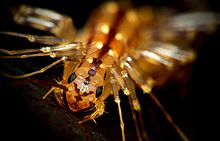Spider runner
| Spider runner | ||||||||||||
|---|---|---|---|---|---|---|---|---|---|---|---|---|

Spider runner |
||||||||||||
| Systematics | ||||||||||||
|
||||||||||||
| Scientific name | ||||||||||||
| Scutigera coleoptrata | ||||||||||||
| ( Linnaeus , 1758) |
The spider runner ( Scutigera coleoptrata ), also known as the spider isopod , is a centipede from the Scutigeridae family . The species, which probably originally came from the Mediterranean region, was also spread by humans in Europe, Asia and North America.
features
Spider runners reach a total length of up to 15 centimeters, of which the actual body is only 25 to 30 millimeters. They are olive green to yellow with three dark vertical stripes along the back that can be black, blue, purple, or green. The legs are ringed black. The head is large and hemispherical with conspicuous complex eyes with 100 to 200 ommatidia each . The side antennas are very long and have up to 300 links. A shaft organ sits on its basal phalanx . A small Tömösvary organ lies between the eye and the antenna . The mandibles are very large. The first maxillae have bristles and appendages on the abdomen to clean the antennae and legs. As with other Scutigeridae , but unlike most centipedes, the body is round in cross-section. In adult animals it has 15 segments , each with a pair of legs, but whose back plates (tergites) are fused to form seven plates, each with a central breathing hole . The legs are very long and get longer from front to back. In contrast to the two common centipedes, they are equipped with 34 or more individual muscles. The well-developed Coxae have an abdominal spur, prefemur , femur and tibia, longitudinal rows of short spines and three long terminal spines. The trochanter is reduced. The long, multi- link tarsi have bristles and hooks on the underside. The last and longest pair of legs is not used for locomotion and probably functions as a rear organ of touch.
Way of life
Activity and locomotion
The nocturnal spider striders live predatory on other arthropods. They are among the fastest runners among the arthropods and can reach speeds of up to 420 millimeters per second (~ 1.5 km / h) with a step width of 33 millimeters. This is made possible by various adjustments. The reduced number of legs compared to other centipedes with increasing length along the trunk allows free, far-reaching movement of the individual legs. The complex musculature enables a rotating movement on the enlarged coxae, whereby the leg is moved further back than forwards and power is sacrificed in favor of speed. The reduced number of back plates stiffens the torso to reduce sideways snaking movements. The metabolism required for rapid locomotion is supported by a highly developed respiratory system, which consists of multi-branching tracheas that are supplied with muscles to increase gas exchange through 90 to 200 pumping movements per minute. As in other Scutigeridae, hemocyanin occurs as a blood pigment .
distribution
Cobblers are mainly found in the Mediterranean area, but have also been introduced into vineyards in southwest Germany, which are usually located in sunny areas. They feed on insects and spiders, especially flies, and are therefore valued by winegrowers as useful pests. In Germany, the species is mostly found in houses; In the southern Baden region (Kaiserstuhl area), the animals can also be found outside of human structures.
literature
- Charles A. Acosta: The House Centipede (Scutigera coleoptrata; Chilopoda): Controversy and Contradiction . In: Journal of the Kentucky academy of science . tape 64 , no. 1 , 2003, p. 1–5 (English, full text (pdf, English; 535 kB) ).
- Jeffrey K. Barnes: House centipede . In: Arthropod museum notes . No. 19 , 2003 (English, full text ).
Web links
- Spider Runner at Invertebrate Anatomy Online (English)
Individual evidence
- ^ A b Charles A. Acosta: The House Centipede (Scutigera coleoptrata; Chilopoda): Controversy and Contradiction . In: Journal of the Kentucky academy of science . tape 64 , no. 1 , 2003, p. 1–5 (English, full text (pdf, English; 535 kB) ).
- ↑ Colin Little: The colonization of land: origins and adaptations of terrestrial animals . Cambridge University Press, 1983, ISBN 0-521-25218-0 , pp. 136 .
